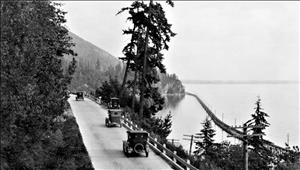On July 3, 1928, a northbound Mount Vernon-Bellingham trolley derails on the interurban track near Inspiration Point in Bellingham. The car somersaults nearly 30 feet down an embankment, sending screaming, flailing riders flying through the car. Eighteen of the trolley's 20 passengers are injured. All eventually recover, but it's the beginning of the end for the Trolley That Went to Sea.
A Strange Sudden Pause
The Bellingham and Skagit Interurban Railway -- nicknamed "The Trolley That Went to Sea" because its route included a four-mile trestle just off the shoreline of Samish Bay -- had operated on a scenic route between Bellingham in Whatcom County and Mount Vernon in Skagit County since 1912. At first it was popular with the public, but ridership on the interurban dropped during the 1920s as buses and cars became more common.
A single trolley car held 58 people, but by the summer of 1928 it was common for cars on the route to be less than half full. Tuesday afternoon, July 3, was no exception. Twenty passengers were aboard a single car as it crossed into the Bellingham city limits near Inspiration Point, traveling at 30 m.p.h., its normal speed of for that part of the route. It was between 3:30 and 3:45 p.m.
Nearby, farmer Dick Burfiend was working in a hayfield and heard the trolley approaching. As always, it blew its whistle and rang its bell as it neared his road crossing -- then instead of continuing as it normally did, the sound abruptly stopped. No trolley appeared, just a strange sudden pause, and Burfiend knew something was wrong. "I stopped work and wondered," he told the Bellingham Herald. "Then came the terrific crash and I knew it was wrecked" ("Gildersleeve, Head Man ... ").
A Tumbling Trolley
The car derailed as it rounded a curve about 300 feet north of the Inspiration Point station. The cause of the accident wasn't immediately clear. Many contended that the rails had spread, allowing the wheels to leap the track, and evidence of loose rails was found at the accident scene immediately after the wreck. Others said the car just jumped the rails. Either way, the rear wheels left the track and bumped along the ties for nearly 70 feet and then along the railbed for another 90 feet. Screams arose as passengers realized something was wrong. Finally the car veered to the outside of the curve with such force that it flipped off the railbed and began rolling down a slope.
Most passengers hadn't had time to brace themselves or grab anything solid as the trolley began its tumble, and 20 men, women, and children were thrown about the car in every direction. It somersaulted down the embankment, turning completely over before coming to rest on its left side. The Bellingham Herald provided a grisly description of the aftermath:
"The ceiling of the car is a light form of building material similar to beaverboard. This was punched through in many places where the heads, arms, legs, and bodies of the passengers had been thrown with great force. One impression showed where a man's back and head and elbows had punched holes. One of the hardwood panels in the car bore a wisp of blonde hair from the head of some girl or woman, where it had struck so hard that the hair had been imbedded in the varnish" ("Gildersleeve, Head Man ...").
The car came to rest against a sturdy growth of young trees. People who were able crawled out, helping others who were more seriously injured. The white seat-top covers -- "which are laundered regularly," assured the Herald ("Northbound Car ...") -- were used as temporary towels and for first aid. Eighteen of the car's 20 passengers were injured, mostly from cuts and bruises, though two people reported broken bones. One passenger, identified as W. F. Kramer of Lakeway Drive in Bellingham, emerged from the car with a large splinter from the car's woodwork protruding from his head just above his right eye. Burfiend and his wife used a knife blade to pry the splinter up so they could get a grip on it and pull it out; the splinter measured more than five inches long. But Kramer was lucky -- the splinter went into his eye socket but not the eye itself, and he did not lose his eye.
Accelerating the Inevitable
Everyone on the trolley was lucky that day. Some spent time in the hospital, but all eventually recovered from their injuries. The interurban itself wasn't as fortunate. While normal service resumed the next morning, the accident brought a lot of negative attention to a trolley line whose days were already numbered. A second accident two months later only accelerated the inevitable. On October 10, 1928, the Trolley That Went to Sea made its last passenger run. Freight service continued for another year and a half, until the line was officially abandoned on June 1, 1930.
In 2014 a six-and-a-half mile stretch of the interurban's route survives as the Interurban Trail, whose route stretches from Bellingham's Fairhaven District south to Larrabee State Park.

